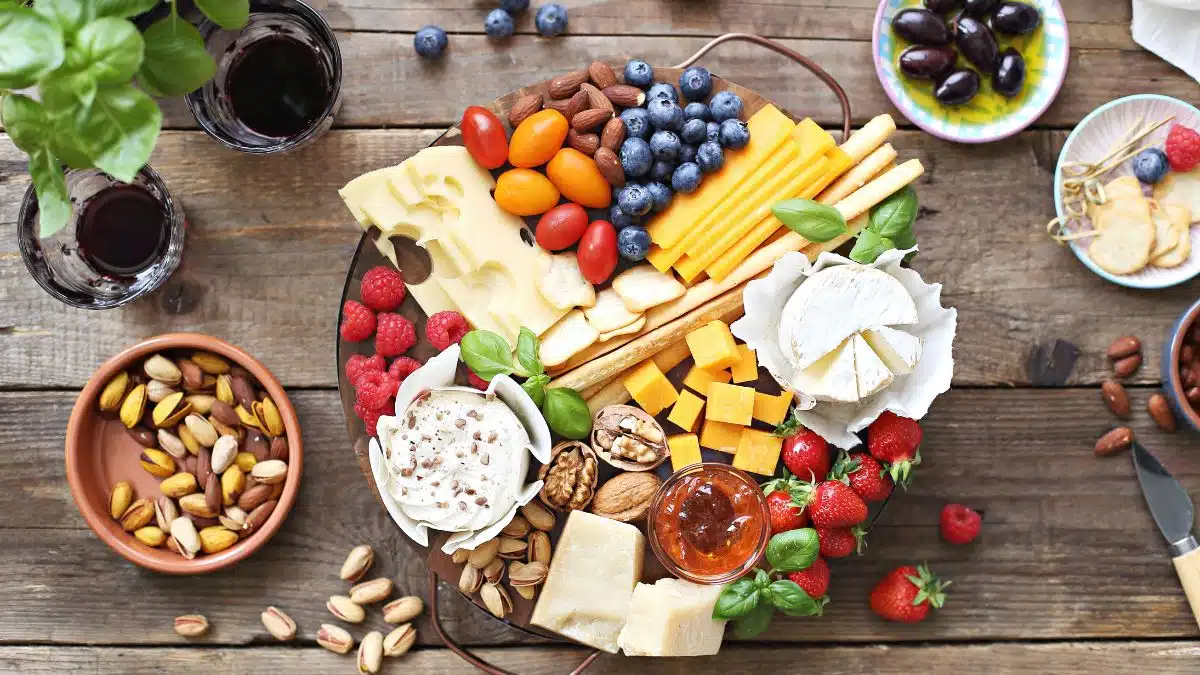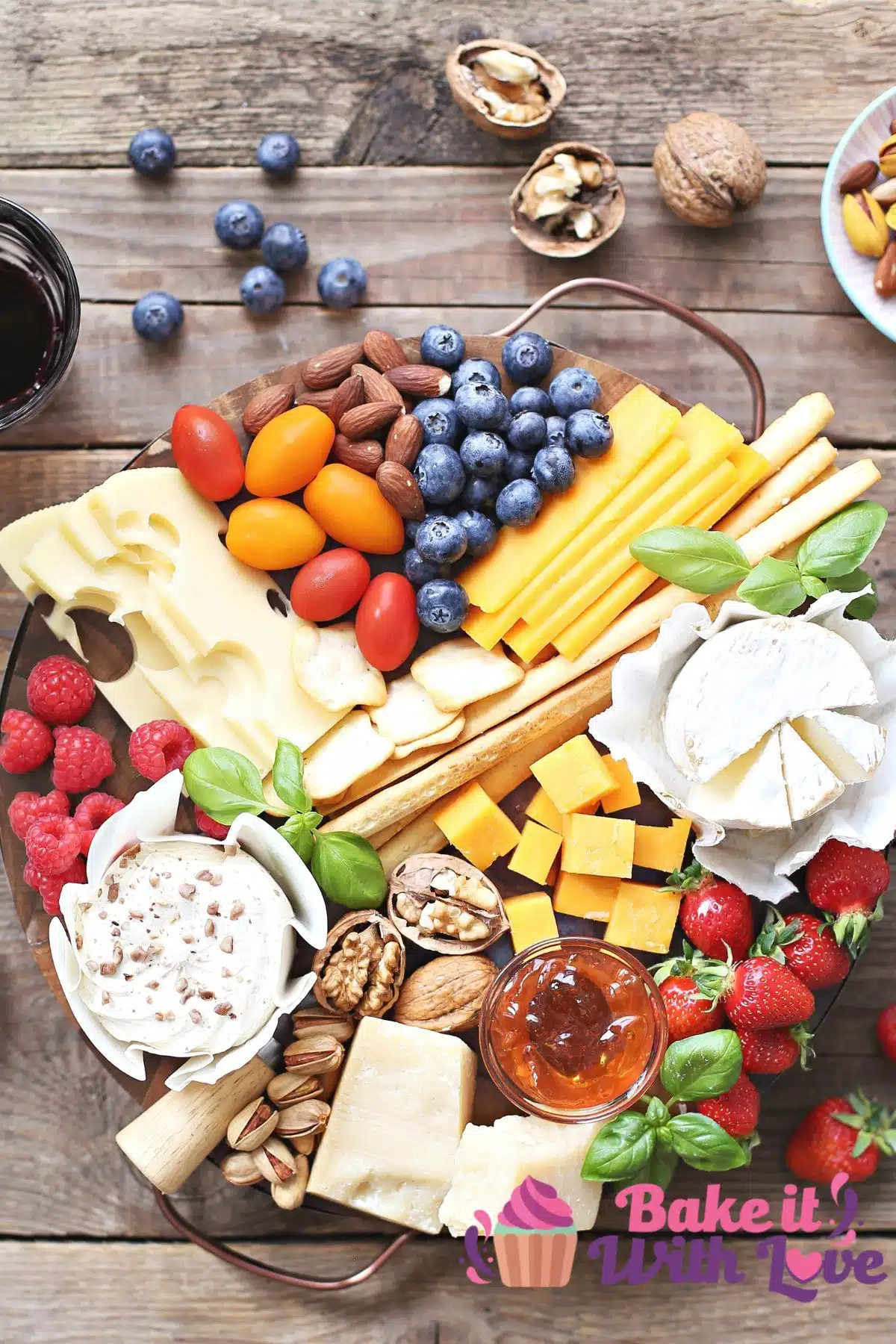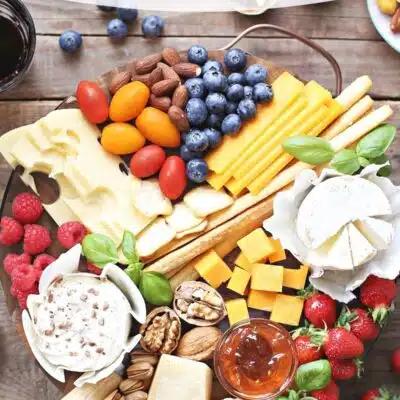A cheese platter is an impressive appetizer that's incredibly easy to make for any party, gathering, or get-together! I cover tips and tricks to help you assemble an amazing assortment of cheese and accompaniments that will make the most enticing platter ever! Plus, I even walk you through how to arrange, label, and present your cheese platter too!
How To Make A Cheese Board
If you are looking for the best tips and tricks to help you make an impressive and delicious cheese platter, you're in the right place! I'm here to walk you through step-by-step on how to create a cheese platter that's not only visually appealing but also bursting with amazing flavors and textures!
This ultimate guide covers how to select the right cheeses, the best accompaniments to pair with, and how to arrange everything perfectly! So gather your favorite cheeses, fruits, nuts, and condiments, and let's get started.

Jump to:
- How To Make A Cheese Board
- What Is A Cheese Platter
- How To Make A Cheese Platter
- 1. Choose Your Cheeses
- 2. Choose Accompaniments
- 3. Arrange Cheese
- 4. Add Accompaniments
- 5. Label
- 6. Serve & Enjoy
- Types Of Cheese For A Cheese Board
- How Much Cheese Per Person
- Cheese Platter vs Charcuterie
- 😋 More Tasty Appetizers
- 📖 Recipe Card
- 💬 Comments & Reviews
What Is A Cheese Platter
A cheese platter is a presentation of various types of cheese, often accompanied by other foods such as crackers, bread, fruits, meats, and nuts! They are served as an appetizer or a snack and make an elegant addition to any occasion!
They're a popular choice for entertaining because the platter can be customized to suit different tastes and dietary needs! You can either make them family-friendly or more suitable for adult tastes. Plus, there are so many options when it comes to building a cheese platter, so there's really no wrong way to do it!
How To Make A Cheese Platter
Making a cheese platter is incredibly easy! All you have to do is select a few varieties of your favorite cheeses and add some ingredients to help fill up the platter.
The trick is starting with the largest pieces of cheese and then adding everything else into the blank spaces. You can even add small bowls on top of the platter to hold any honey, jams, or smaller items like nuts if desired. This will help create more dimension in your presentation!
1. Choose Your Cheeses
Start your cheese platter by selecting 3-5 varieties of cheeses with different textures, flavors, and milk types! For example, you could include soft cheese like brie or camembert, hard cheese like cheddar or gouda, blue cheese like Roquefort or Stilton, and goat or sheep's milk cheese.
You can also choose cheeses from different regions or countries to add variety! (See below for more ideas of cheese types to use).
Some of my favorite cheeses to include are:
- Parmesan
- Aged Cheddar
- Smoked Gouda
- Muenster
- Butterkäse
- Mascarpone
- Brie
- Blue Cheese
- Gorgonzola
- Gruyere
- Chèvre
2. Choose Accompaniments
Choose a variety of accompaniments to pair with the cheeses and help fill up your platter! This can include crackers, bread, sliced baguettes, fruits such as grapes, apples or figs, nuts, olives, honey, and jams.
Keep in mind that you will want this appetizer to be visually appealing when you are making your choices. Think of adding different colors to help brighten up the platter. For example, can add different colored grapes, berries, and/or apples!
Here are some of the accompaniments that my family enjoys:
- Walnuts
- Almonds
- Gherkins
- Blueberries
- Raspberries
- Grapes
- Dried Apricots
- Dried Dates
- Figs
- Cherry Tomatoes
- Cucumber Slices
3. Arrange Cheese
Place the cheese on a platter or large cutting board, starting with the larger pieces of cheese. Leave enough space between the cheeses to access each type easily.
You can choose to either slice your cheese or cube your cheese and stack them up so that it's easier for your guests to grab. Also, this creates height differences which help the overall look. Soft cheeses like goat cheese or brie can be served as is with cheese knives.
Make sure to let your cheese sit out for at least 30 minutes so that they come to room temperature. If you are worried that they will dry out, you can either wrap them in plastic wrap or beeswax wrap while they sit out on the counter.
4. Add Accompaniments
Add the accompaniments around the cheese, keeping in mind that you want to create an aesthetically pleasing display. I like placing crackers or slices of bread in a separate bowl or basket, or you can use them to make a border around your platter.
Arrange the fruits, nuts, and olives around the cheese in the empty holes to fill the platter. Drizzle honey over some of the cheeses or serve it in a small bowl with a honey dipper.
5. Label
Label each cheese, so guests know what they are eating! You can use small signs or labels on toothpicks to identify each cheese. This is a chance to get super creative and really make your cheese presentation pop!
6. Serve & Enjoy
Your cheese platter will be served once everything is arranged. Encourage guests to try different combinations of cheese and accompaniments and enjoy!
>>>>See all of my recipes here<<<<

Types Of Cheese For A Cheese Board
When putting together a cheese board, it's important to choose a variety of cheeses that offer different flavors, textures, and milk types. Aim for a mix of soft, hard, blue, semi-soft, and fresh cheeses to create a well-rounded cheese board that will appeal to all tastes.
Soft Cheese
Soft cheeses like Brie, Camembert, and goat cheese are always a hit on a cheese board. These cheeses are typically mild and creamy, with a buttery texture that pairs well with crackers, bread, and fruit!
Brie is a French cheese that is soft and buttery with a mild flavor. It pairs well with sweet fruits like grapes and figs.
Camembert is a French cheese that is similar to Brie but has a slightly stronger flavor.
Goat cheese is a tangy, creamy, versatile cheese that pairs well with various accompaniments.
Hard Cheese
Hard cheeses like Cheddar, Gouda, and Parmesan are other staples of a great cheese board! These cheeses are typically sharper and nuttier in flavor, with a firm texture that pairs well with cured meats and olives.
Cheddar is a British cheese in various flavors, from mild to sharp, and Gouda is a Dutch cheese that is nutty and slightly sweet in flavor.
Parmesan is an Italian, hard, salty cheese with a rich, umami flavor. It is perfect for grating over salads or pasta!
Blue Cheese
Blue cheese like Roquefort, Stilton, and Gorgonzola adds a strong, tangy flavor to a cheese board. These cheeses pair well with sweet accompaniments like honey and figs.
Roquefort is a French cheese that is sharp and salty with a slightly sweet aftertaste. Stilton is an English cheese milder than Roquefort with a creamy texture. Gorgonzola is a crumbly and tangy Italian cheese with a distinct blue veining.
Semi-Soft Cheese
Semi-soft cheeses like Havarti, Fontina, and Gruyere are all delicious choices for a cheese board. These cheeses offer a range of flavors and textures and pair well with sliced meats, nuts, and dried fruit.
Havarti is a Danish cheese that is creamy and buttery with a mild flavor. Fontina is a nutty and slightly sweet Italian cheese with a semi-soft texture. Gruyere is a Swiss cheese that is nutty and slightly salty with a firm texture.
Fresh Cheese
Fresh cheeses like mozzarella, ricotta, and feta add a light and refreshing touch to a cheese board. These cheeses pair well with fresh fruits and vegetables like cherry tomatoes and cucumber slices.
Mozzarella is an Italian cheese that is soft and mild with a delicate flavor. Ricotta is a creamy and slightly sweet Italian cheese, perfect for spreading on crackers or bread. Feta is a Greek cheese that is tangy and salty with a crumbly texture, perfect for pairing with olives and roasted vegetables.
How Much Cheese Per Person
When building a cheese platter, you will want to aim to serve around 2-3 ounces of cheese for each person. This amount is great for when you are making a cheese platter for a smaller crowd. If you are serving the cheese platter as a main course, then you can simply add more and plan for 4-5 ounces per person!
Cheese Platter vs Charcuterie
Cheese platters and charcuterie boards are popular appetizers or snacks during gatherings and events. They both consist of various tasty items arranged in an appealing way for presentation, but what makes them different?
As the name suggests, a cheese platter's main focus is cheese! Even though it does have accompaniments, the platter should mainly showcase different types of cheese, ranging from soft to hard.
On the other hand, a charcuterie board primarily centers around cured meats like salami, prosciutto, sausages, and paté.

😋 More Tasty Appetizers
- Ground Beef Taquitos - An easy and flavorful dish made with rolled corn tortillas stuffed with perfectly seasoned ground beef!
- Risotto Balls - This recipe is a must-try if you love Italian food and easy appetizers!
- Olive Dip - A delicious and savory appetizer made with salty green olives, cream cheese, mayonnaise, and cheddar cheese!
- Fajita Quesadillas - An easy and quick appetizer loaded with all your favorite fajita ingredients!
- Cream Cheese Salsa Dip - This delicious dip is made with 2 ingredients and can be served hot or cold!
- Fresh Mango Salsa - This refreshing salsa can be enjoyed with chips or add it to your favorite tacos!
What do you think now that you know how to build your cheese platters? Do you have a favorite type of cheese that you always include in your cheese boards? Leave me a comment down below to let me know!
Do you love a recipe you tried? Please leave a 5-star 🌟rating in the recipe card below and/or a review in the comments section further down the page.
Stay in touch with me through social media @ Pinterest, Facebook, Instagram, or Twitter! Subscribe to the newsletter today (no spam, I promise)! Don't forget to tag me when you try one of my recipes!
📖 Recipe Card
Cheese Platter
Ingredients
Cheese
- 10 oz aged or hard cheese (sliced or cubed - cheddar, colby-jack, manchego, muenster, provolone, edam, gouda)
- 5 oz soft & semi-soft cheese (brie, burrata, mascarpone, gruyere, havarti, fontina, camembert, chevre)
- 5 oz crumbled cheese (goat cheese, feta, ricotta, mozzarella)
Nuts
- 2 oz almonds (or pistachios, cashews, or macadamia nuts)
- 2 oz walnuts (or pecans or filberts)
Fruit
- 2 cups grapes (mix of red and green seedless grapes)
- 2 cup apples (sliced)
- ½ cup dried dates (or dried apricots)
Sweets
- ¼ cup honey (or jalapeno jelly)
Other Accompaniments
- olives (black or green)
- crackers (Triscuit, wheat thins, grissini breadsticks, cheese whisps)
- baguette (sliced)
(Note: 2x or 3x only changes the ingredient list)
Instructions
- Place the cheese on a platter or board, starting with the larger pieces of cheese. Leave enough room between each type of cheese for easy access.
- Choose a variety of nuts, fruits, sweets, or other accompaniments to pair with the cheeses. Arrange them around the cheese with crackers or bread slices in a separate bowl or basket to the side.
- Use small signs or labels on toothpicks to label each cheese (optional).
- Serve right away and enjoy the different flavor combinations.
Notes
- To save time, you can slice or crumble the cheese in advance and keep them refrigerated in sealed storage bags or airtight containers.
- Typically cheese is served at room temperature for a cheese platter, so take the cheese out of the fridge 30 minutes to 1 hour before you're ready to enjoy.
- Plan to serve each person 2-3 ounces of cheese when making a smaller cheese platter and 4-5 ounces for a larger platter.
- To store: If you have leftovers, place each individual cheese into an airtight container or sealed storage bag in the fridge. Reference the expiration dates on the packages for each variety of cheese for how long they will last.



Sheridan says
This worked exactly as written, thanks!